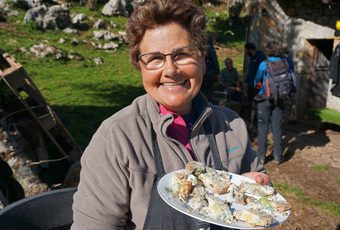The Weavers of Chinchero
To make sense of some of these photos, it might help to have a description of the process involved in producing a traditional woven fabric here in the Peruvian Andes.
The process is that the wool (sheep, llama or alpaca for the nicest pieces) is coloured using natural dyes. These are plants in many cases, for the reds they are cochineal which are harvested from cacti where they live in their millions.
Once coloured, the wool is pulled it into some semblance of a thread by hand before winding it onto a spool. Basically you keep the spool spinning to wind up the thread as you stretch it from the raw wool. After a full spool is done, the process is reversed with the spool spun in the opposite direction so the thread becomes both finer, and stronger. Depending on how fine the weaving is, this process is repeated. The thread I managed to make would be appropriate for knitting a weak hammock, the women at Chinchero make thread fine enough to make the wings of a baby angel.
The next stage is for two women to create the warp, the longitudinal yarn. This they do with the help of a couple of stakes in the ground. With one woman seated behind each stake, they essentially throw a ball of yarn to each other, wrapping it around each stake and creating the basic pattern of coloured stripes.
From here it is to the ‘master’ weavers, who work on back-strap looms. These are effectively harnesses which they can lean back into, creating the tension for working the weft (the traverse yarns) and ultimately making the intricate patterns. Given just how fine the yarn is and the complexity of the patters, this is the part of the process which is most mind-boggling to watch!
Each community has their own unique patterns so if you are walking up in the Andes, the colour and patterns of clothing will indicate which community the wearer belongs to. In Chinchero, the weavings have borders, just to add an additional layer of complexity!
It’s an extraordinary fact that none of the patterns are written down anywhere, they are passed from generation to generation purely by word of mouth and practice.
Our Peru holidays Get in touch Subscribe to The Pothole
The Pothole is Pura Aventura's popular monthly email. We share what we love, what interests us and what we find challenging. And we don't Photoshop out the bits everyone else does. We like to think our considered opinions provide food for thought, and will sometimes put a smile on your face. They've even been known to make people cry. You can click here to subscribe and, naturally, unsubscribe at any time.
The Pothole is Pura Aventura's popular monthly email. We share what we love, what interests us and what we find challenging. And we don't Photoshop out the bits everyone else does. We like to think our considered opinions provide food for thought, and will sometimes put a smile on your face. They've even been known to make people cry. You can click here to subscribe and, naturally, unsubscribe at any time.






